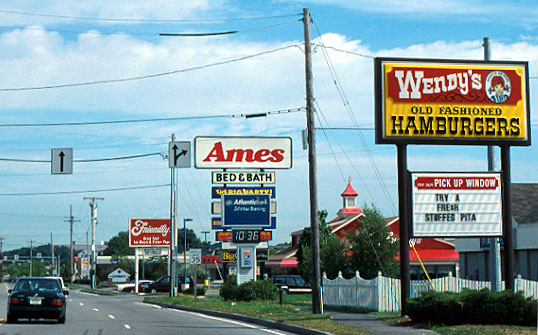Travel out any distance, and soon you're on a suburban commercial strip. The strip combines land-gobbling sprawl with the artificiality of themed stores and malls, with its endless garish seductions and banal repetitions.
Despite its frequent ugliness, the commercial strip is showing us a new kind of order that can be found more and more in our world: the list with links. The street has become a list. Each item vies seductively for your attention. When you choose one item on the list and enter its building you find a mall, which is another list offering more seductions. But items on the list may have links that are invisible. You cannot understand the form of the strip -- or anywhere in suburban sprawl -- just by looking at it, because its form involves connections other than spatial proximity. The horizon within which the strip gets its meanings is far wider than its spatial neighborhood.

One branded island abuts another: McDonald's next to Staples next to Kinko's Copies. Strip transitions are abrupt and follow no order: food, lodging, Chinese food, tires, travel agency, burgers, book store, animal hospital. Nor is there continuity in time; substantial-looking enterprises suddenly disappear and are abruptly replaced.
Driving the strip one scans a list just as when reading the ads in the newspaper, or the Yellow Pages, or surfing the Web's lists. You travel facing discontinuity and seductions. Whether one scans for a purpose or for impulse the list remains.
(c) David Kolb, 1 August 2001